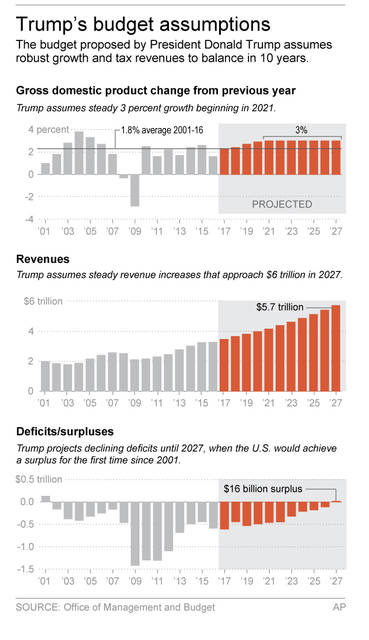WASHINGTON — President Donald Trump fulfilled a major campaign promise Tuesday, proposing a $4.1 trillion budget plan that would upend Washington in a big way. But he drew rebukes, even from some Republican allies, for the plan’s jarring, politically unrealistic cuts to the social safety net for the poor and a broad swath of other domestic programs.
WASHINGTON — President Donald Trump fulfilled a major campaign promise Tuesday, proposing a $4.1 trillion budget plan that would upend Washington in a big way. But he drew rebukes, even from some Republican allies, for the plan’s jarring, politically unrealistic cuts to the social safety net for the poor and a broad swath of other domestic programs.
The budget, Trump’s first as president, combines his spending plan for the upcoming 2018 fiscal year with a promise to balance government books after a decade, relying on aggressive cuts, a surge in economic growth — and a $2 trillion-plus accounting gimmick.
“Through streamlined government, we will drive an economic boom that raises incomes and expands job opportunities for all Americans,” Trump declared in his budget message.
“Basically dead on arrival,” opined the Senate’s No. 2 Republican, John Cornyn of Texas.
The proposal reflects a conservative vision of smaller government, a drastic rollback of programs for the poor and disabled to prod them into the workforce and a robust hike for the military and border security. It foresees scuttling Barack Obama’s health care law and an overhaul of the tax code, a boon to the wealthiest Americans.
The plan is laced with $3.6 trillion in cuts to domestic agencies, food stamps, Medicaid, highway funding, crop insurance and medical research, among others. Many of the voters who propelled Trump into the presidency last November would see significantly less from the federal government.
“We’re no longer going to measure compassion by the number of programs or the number of people on those programs, but by the number of people we help get off those programs,” said Mick Mulvaney, director of the Office of Management and Budget and a former tea party congressman.
At the same time, the blueprint boosts spending for the military by tens of billions and calls for $1.6 billion for a border wall with Mexico that Trump repeatedly promised voters the U.S. neighbor would finance. Mexico emphatically rejects that notion.


